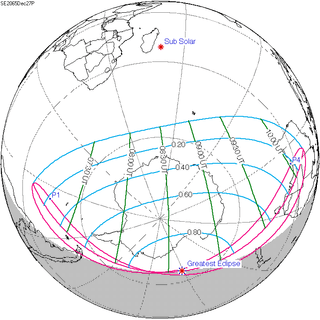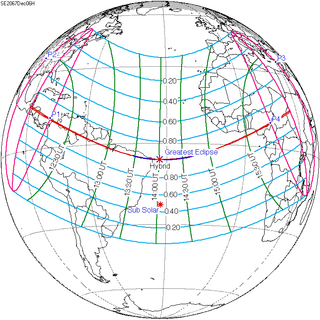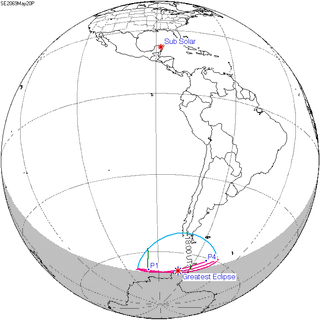Solar eclipse of June 11, 2067
| Solar eclipse of June 11, 2067 | |
|---|---|
 Map | |
| Type of eclipse | |
| Nature | Annular |
| Gamma | -0.0387 |
| Magnitude | 0.967 |
| Maximum eclipse | |
| Duration | 245 sec (4 m 5 s) |
| Coordinates | 21°00′N 130°12′W / 21°N 130.2°W |
| Max. width of band | 119 km (74 mi) |
| Times (UTC) | |
| Greatest eclipse | 20:42:26 |
| References | |
| Saros | 138 (34 of 70) |
| Catalog # (SE5000) | 9658 |
An annular solar eclipse will occur on June 11, 2067. A solar eclipse occurs when the Moon passes between Earth and the Sun, thereby totally or partly obscuring the image of the Sun for a viewer on Earth. An annular solar eclipse occurs when the Moon's apparent diameter is smaller than the Sun's, blocking most of the Sun's light and causing the Sun to look like an annulus (ring). An annular eclipse appears as a partial eclipse over a region of the Earth thousands of kilometres wide.
Related eclipses
Solar eclipses 2065-2069
Each member in a semester series of solar eclipses repeats approximately every 177 days and 4 hours (a semester) at alternating nodes of the Moon's orbit.
| 118 | July 3, 2065 Partial |
123 | December 27, 2065 Partial |
| 128 | June 22, 2066 Annular |
133 | December 17, 2066 Total |
| 138 | June 11, 2067 Annular |
143 | December 6, 2067 Hybrid |
| 148 | May 31, 2068 Total |
153 | November 24, 2068 Partial |
| 158 | May 20, 2069 Partial |
References
External links
- Earth visibility chart and eclipse statistics Eclipse Predictions by Fred Espenak, NASA/GSFC
| Wikimedia Commons has media related to Solar eclipse of 2067 June 11. |

